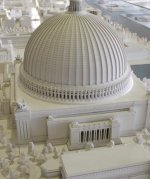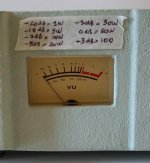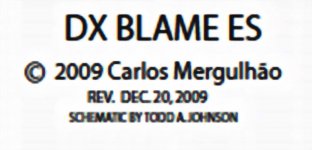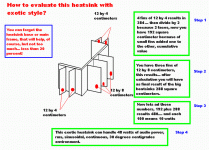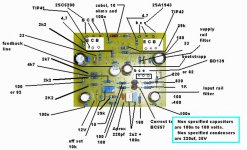Dx amplifier enclosure was inspired into the II world war Nazi architecture
Albert Speer designs related the 1000 years Reich.
No!...i am not Nazi, but something results good from that... Albert Einstein gone to USA, the nuclear energy, the Jet planes, Messerchmitt ME262, the enigma code machine, Werner Von Braun and the rockets that resulted into the rockets that sent the man to the moon.
Well..something was good, despite the majority of things was terrible.
regards,
Carlos
Albert Speer designs related the 1000 years Reich.
No!...i am not Nazi, but something results good from that... Albert Einstein gone to USA, the nuclear energy, the Jet planes, Messerchmitt ME262, the enigma code machine, Werner Von Braun and the rockets that resulted into the rockets that sent the man to the moon.
Well..something was good, despite the majority of things was terrible.
regards,
Carlos
Attachments
Last edited:
Yes, i have build three times, the first time exploded, the second time
was not aproved by my group of friends that helps me to evaluate sonics, that one was killed, receive a double barreled shot, a beautifull hole from a 12 gauge in the middle of the board, shot was pointed to the ground, soft garden ground.....0 centimeters distant...boooom!, the board was made in pieces, but the central hole could be detected because smoked......fine!
The third time was to tweak to obtain nice sonics....then i give up... no good sonics to my ears....no more Leach in my life.
But, despite my feelings about, there are thousands that loves the Leach amplifier, and in Brasil, almost all professional amplifiers, made from 1975 to 1995 was made using the leach style amps, double simetrical differential, double vas, double crossover distortion and so on.
Also, everybody that enters the forum goes building the Leach amplifier, seems to me the simetrical has enormous appeal, it is very atractive...hehehehe, go and build and them tell me.
Merry Christimas and a happy new year, with Ketchup or Mustard, but be happy!
regards,
Carlos
was not aproved by my group of friends that helps me to evaluate sonics, that one was killed, receive a double barreled shot, a beautifull hole from a 12 gauge in the middle of the board, shot was pointed to the ground, soft garden ground.....0 centimeters distant...boooom!, the board was made in pieces, but the central hole could be detected because smoked......fine!
The third time was to tweak to obtain nice sonics....then i give up... no good sonics to my ears....no more Leach in my life.
But, despite my feelings about, there are thousands that loves the Leach amplifier, and in Brasil, almost all professional amplifiers, made from 1975 to 1995 was made using the leach style amps, double simetrical differential, double vas, double crossover distortion and so on.
Also, everybody that enters the forum goes building the Leach amplifier, seems to me the simetrical has enormous appeal, it is very atractive...hehehehe, go and build and them tell me.
Merry Christimas and a happy new year, with Ketchup or Mustard, but be happy!
regards,
Carlos
Last edited:
Everything about the Dx amplifier in Portuguese.... 21 Mega is the size
You can download and use the google translator.
https://www.yousendit.com/transfer....533720&email=a910b9405c71b0de29e675e8f1d1e65d
This will be ready to download for a week only, thanks to Soundbuster that have collected the stuff into a Brazilian forum and also into the Orkut.
regards,
Carlos
You can download and use the google translator.
https://www.yousendit.com/transfer....533720&email=a910b9405c71b0de29e675e8f1d1e65d
This will be ready to download for a week only, thanks to Soundbuster that have collected the stuff into a Brazilian forum and also into the Orkut.
regards,
Carlos
A new Dx amplifier, the Dx Blame ES
There's a thread about, soon a professional schematic and the pcboard will be made.
A preliminary, temporary, a draft about the pcboard is beeing prepared to Brazilians (Orkut group of simple non fanatic hobbie guys)
The amplifier was built, was tested and it is working absolutelly great...eating everyone (include mine one) into the breakfast.
There's a thread running now, look here:
http://www.diyaudio.com/forums/soli...into-blameless-i-am-trying-new-amplifier.html
No one can beat this one!
regards,
Carlos
There's a thread about, soon a professional schematic and the pcboard will be made.
A preliminary, temporary, a draft about the pcboard is beeing prepared to Brazilians (Orkut group of simple non fanatic hobbie guys)
The amplifier was built, was tested and it is working absolutelly great...eating everyone (include mine one) into the breakfast.
There's a thread running now, look here:
http://www.diyaudio.com/forums/soli...into-blameless-i-am-trying-new-amplifier.html
No one can beat this one!
regards,
Carlos
Attachments
Last edited:
Dear Carlos and friends,
First of all let me wish you all a very happy new year 2010 !
Sorry for not being in touch with you all.. But I have not given up Dx corporation.
Past few days I have tested Dx with a few amps.. Dx beats all of them by sound quality..
I wish if I can use Dx as a car amplifier with an SMPS.. I only concern the power efficiency (heating energy) and I'm sorry I dont know how to calculate those.. I heard FETs will generate low heat but poor sound quality..
Thanks all !
First of all let me wish you all a very happy new year 2010 !
Sorry for not being in touch with you all.. But I have not given up Dx corporation.
Past few days I have tested Dx with a few amps.. Dx beats all of them by sound quality..
I wish if I can use Dx as a car amplifier with an SMPS.. I only concern the power efficiency (heating energy) and I'm sorry I dont know how to calculate those.. I heard FETs will generate low heat but poor sound quality..
Thanks all !
The amplifier is a classic class AB amplifier, eficiency is around 50 percent alike
others, you need 10 by 10 centimeters aluminium plate to each 10 watts of rms audio power.
To evaluate the heatsinks you may have at home, or even units to be sold in shops or internet, calculate area exposed to the air, both faces calculated,both aluminium face sides and them divide by two, and then enter the rule of three numbers to know how that unknow heatsink can hold in rms audio watts power.
You see, this is already converted to audio rms power,not heat, not watts of heat, not peak nor peak to peak.
So, a 50 watts rms audio amplifier (Dx amplifier working with 8 ohms speaker and 35 plus 35 volts in the power supply) needs the equivalent of 5 blades of aluminium exposed to the free air (out from case, out from enclosure, outside the cabinet) to dissipate the heat.
2 channels will need twice the number of blades, and if working 4 ohms you will multiply by four.
Imagine you found a heatsink with 16 fins, and each one of them measure 10 by 15 centimeters.
Each thin is 300 square centimeters, multiplied by the number of fins result 4800 square centimeters...then divide by two, this results 2400 square centimeters,
As each 10 by 10 centimeters (200 square centimeters divided by two result 100 square centimeters) hold 10 watts rms.... how many 100 square centimeters you have inside 2400 square centimeters?
24 times 10 watts!
Means the heatsink is able to dissipate 240 watts rms of AUDIO power, sinusoidal, continuous steady tone, in a 30 degrees centigrade environment.
Yes, we have more than fins, we have the heatsink base panel, and has length and high, and this dissipates too, but really not too much because heat turbulence under convection, you can forget the base for simplification purposes.
Attached an image, an example, how to calculate a strange heatsink with different shape.
This is all i can do for help you dear Lycanlk.
regards,
Carlos
others, you need 10 by 10 centimeters aluminium plate to each 10 watts of rms audio power.
To evaluate the heatsinks you may have at home, or even units to be sold in shops or internet, calculate area exposed to the air, both faces calculated,both aluminium face sides and them divide by two, and then enter the rule of three numbers to know how that unknow heatsink can hold in rms audio watts power.
You see, this is already converted to audio rms power,not heat, not watts of heat, not peak nor peak to peak.
So, a 50 watts rms audio amplifier (Dx amplifier working with 8 ohms speaker and 35 plus 35 volts in the power supply) needs the equivalent of 5 blades of aluminium exposed to the free air (out from case, out from enclosure, outside the cabinet) to dissipate the heat.
2 channels will need twice the number of blades, and if working 4 ohms you will multiply by four.
Imagine you found a heatsink with 16 fins, and each one of them measure 10 by 15 centimeters.
Each thin is 300 square centimeters, multiplied by the number of fins result 4800 square centimeters...then divide by two, this results 2400 square centimeters,
As each 10 by 10 centimeters (200 square centimeters divided by two result 100 square centimeters) hold 10 watts rms.... how many 100 square centimeters you have inside 2400 square centimeters?
24 times 10 watts!
Means the heatsink is able to dissipate 240 watts rms of AUDIO power, sinusoidal, continuous steady tone, in a 30 degrees centigrade environment.
Yes, we have more than fins, we have the heatsink base panel, and has length and high, and this dissipates too, but really not too much because heat turbulence under convection, you can forget the base for simplification purposes.
Attached an image, an example, how to calculate a strange heatsink with different shape.
This is all i can do for help you dear Lycanlk.
regards,
Carlos
Attachments
Last edited:
I do not like to talk about what is my evaluation about fets
They were made for switching power supplies, low resistance when the state is on and very high resistance when the state is off.
Can hold big current, the base is sensitive to destruction, not linear as normal transistors (BGT)
I do not like the sonics, i do not like them, but there are controversies.
Keep the old and good normal transistors for safety reasons my dear, do not enter that adventure.
Sounds strange to me, the sonics are strange to me.
Other love them deeply, so, there are several different opinions about, nothing is absolute in our universe...also nothing is solid, nor lead or iron or gold.
There are enormous empty spaces between electrons..things are not the way we imagine, fets too!
Wanna a clue, if i was not clear enougth?.... i have around 100 power fets, i am not using them, i have used several to test, i have made amplifiers with them, and i am not using them..... understood?
regards,
Carlos
They were made for switching power supplies, low resistance when the state is on and very high resistance when the state is off.
Can hold big current, the base is sensitive to destruction, not linear as normal transistors (BGT)
I do not like the sonics, i do not like them, but there are controversies.
Keep the old and good normal transistors for safety reasons my dear, do not enter that adventure.
Sounds strange to me, the sonics are strange to me.
Other love them deeply, so, there are several different opinions about, nothing is absolute in our universe...also nothing is solid, nor lead or iron or gold.
There are enormous empty spaces between electrons..things are not the way we imagine, fets too!
Wanna a clue, if i was not clear enougth?.... i have around 100 power fets, i am not using them, i have used several to test, i have made amplifiers with them, and i am not using them..... understood?
regards,
Carlos
most FET output stages need a higher supply voltage to deliver the same output power as the equivalent BJT output stage.I heard FETs will generate low heat but poor sound quality..
This high supply voltage results in more power dissipation and lower efficiency.
I believe you...
I built a famous FET amp grabbed from this forum. I dont like to mention his name caz I appreciate his effort. Also It can handle my woofers well but I don't feel much comfortable with it. So I thinks its because of FETs. It produces good bass but not mid and trebles.
And thanks for the info which is enough me to select a good heatsink for Dx amp..
one more thing I have to consider when designing a car amp. That is to save the battery as much as I can. So decisions will tolerate between the quality against efficiency. isn't it?
Since Andrew has mentioned FET too dissipate more energy due to high power operation then the choice is more bias to old type good transistors
I built a famous FET amp grabbed from this forum. I dont like to mention his name caz I appreciate his effort. Also It can handle my woofers well but I don't feel much comfortable with it. So I thinks its because of FETs. It produces good bass but not mid and trebles.
And thanks for the info which is enough me to select a good heatsink for Dx amp..
one more thing I have to consider when designing a car amp. That is to save the battery as much as I can. So decisions will tolerate between the quality against efficiency. isn't it?
Since Andrew has mentioned FET too dissipate more energy due to high power operation then the choice is more bias to old type good transistors
Dx Standard sound special in the low end, excelent for subwoofer
applications, the overal performance is also excelent, despite beated by the Dx Blame ES, still continue to be a lovely amplifiers and there are several folks that have more modern and better performance amplifiers, but they still loves the warm and delicious sonics this amplifier produces (reproduces)
regards,
Carlos
applications, the overal performance is also excelent, despite beated by the Dx Blame ES, still continue to be a lovely amplifiers and there are several folks that have more modern and better performance amplifiers, but they still loves the warm and delicious sonics this amplifier produces (reproduces)
regards,
Carlos
Attachments
I do not think bridge amps sounds fine, they add distortions
And to protect the Dx amplifier good name i will not suggest you to do that.
Of course, any amplifier can be bridged, so the Dx amplifier can be too, and this you know very well.
I do not like the idea, but the amplifier is yours and you do what you want to do...it i up to you.
regards,
Carlos
And to protect the Dx amplifier good name i will not suggest you to do that.
Of course, any amplifier can be bridged, so the Dx amplifier can be too, and this you know very well.
I do not like the idea, but the amplifier is yours and you do what you want to do...it i up to you.
regards,
Carlos
- Status
- Not open for further replies.
- Home
- Amplifiers
- Solid State
- Destroyer x Amplifier...Dx amp...my amplifier
